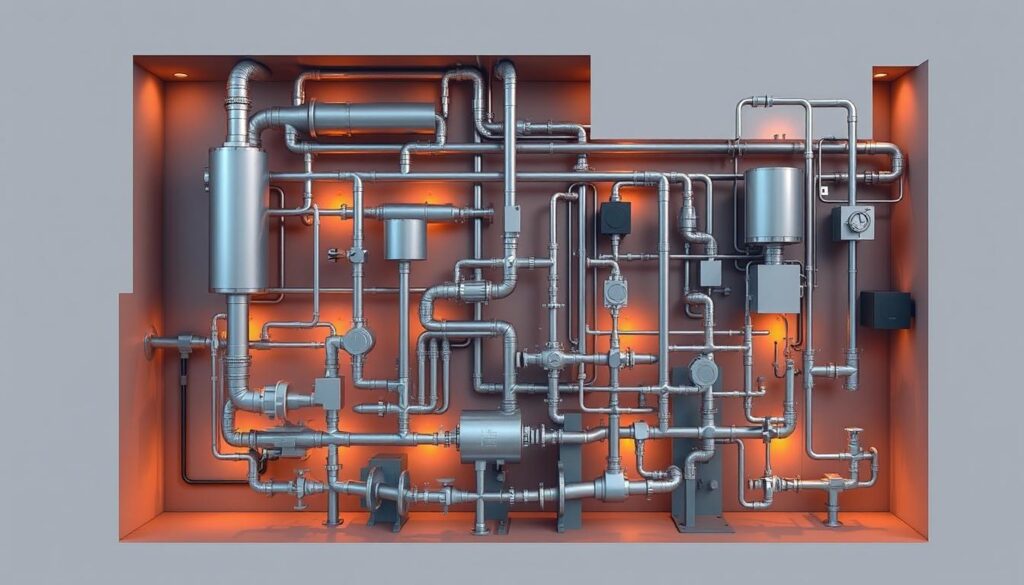A well-designed water supply system is crucial for conserving resources and reducing energy consumption. In the United States, a significant amount of energy is used to treat and transport water for various uses.
An efficient plumbing system starts with a design that saves water and energy resources. According to guidelines from professional development resources, incorporating short runs between plumbing fixtures and using state-of-the-art materials is essential. This not only reduces waste but also minimizes the strain on municipal water supply systems.
Key Takeaways
- Efficient water supply system design is crucial for resource conservation.
- Short runs between plumbing fixtures reduce waste and energy consumption.
- State-of-the-art materials play a significant role in efficient plumbing systems.
- A well-designed system minimizes strain on municipal resources.
- Proper design considerations can significantly impact energy savings.
Understanding Water Supply Systems
Understanding the intricacies of water supply systems is vital for their optimal operation. Water supply systems are complex networks designed to deliver water from its source to the end-user, whether it’s for domestic use, agriculture, or industrial purposes.
Definition and Purpose
A water supply system is defined as the infrastructure that collects, treats, and distributes water. Its primary purpose is to ensure that water is delivered safely and efficiently to meet the demands of the population it serves.
The purpose of a water supply system can be broken down into several key objectives:
- To provide clean and safe drinking water
- To support agricultural and industrial activities
- To maintain public health and hygiene
Key Components of Water Supply Systems
The key components of a water supply system include:
| Component | Description |
|---|---|
| Source | The origin of the water, such as rivers, lakes, or groundwater. |
| Treatment Plant | Facilities that remove contaminants from the water to make it safe for use. |
| Distribution Network | A system of pipes that transports water from the treatment plant to consumers. |
| Storage Facilities | Tanks and reservoirs that store water for later use. |
Water distribution systems are a critical part of this infrastructure, ensuring that water reaches every corner of the community.
Types of Water Supply Systems
There are several types of water supply systems, each designed to meet specific needs:
- Gravity-fed systems, which rely on gravity to distribute water.
- Pumped systems, which use pumps to pressurize the water distribution network.
- Combined systems, which use a combination of gravity and pumping to distribute water.
Understanding these different types is crucial for designing and implementing an efficient water supply system that meets the needs of its users.
Importance of Efficient Water Supply Design
Efficient water supply design is not just about functionality; it’s also about protecting public health and reducing environmental degradation. A well-designed water supply system is the backbone of any community, ensuring that water is delivered safely and reliably to meet the needs of its users.
Impact on Public Health
A well-designed water supply system plays a critical role in preventing the spread of waterborne diseases. By ensuring that water is properly treated and distributed, communities can significantly reduce the risk of outbreaks. Proper water treatment and distribution are key to maintaining public health.
The impact on public health is multifaceted. Not only does it prevent waterborne illnesses, but it also supports overall well-being by providing clean water for drinking, cooking, and hygiene. This is particularly important in densely populated areas where the risk of disease transmission is higher.
Environmental Considerations
Efficient water supply design also has significant environmental benefits. By minimizing leaks and reducing waste, well-designed systems conserve water resources and reduce the energy needed to treat and pump water. This not only helps in preserving our natural resources but also reduces the carbon footprint associated with water supply.
Furthermore, efficient systems help in protecting ecosystems by reducing the amount of wastewater generated and ensuring that water bodies are not polluted. This is crucial for maintaining biodiversity and supporting aquatic life.
Economic Benefits
The economic benefits of efficient water supply design are substantial. By reducing waste and minimizing the need for costly repairs, communities can save significant amounts of money. Efficient water supply systems also support economic development by providing reliable water services to businesses and industries.
| Aspect | Benefits of Efficient Design | Consequences of Poor Design |
|---|---|---|
| Public Health | Reduced risk of waterborne diseases | Increased risk of outbreaks |
| Environmental Impact | Conservation of water resources, reduced carbon footprint | Water waste, increased pollution |
| Economic | Cost savings, support for economic development | Increased costs for repairs and healthcare |
In conclusion, efficient water supply design is crucial for protecting public health, reducing environmental degradation, and supporting economic development. By investing in well-designed water supply systems, communities can reap significant benefits in these areas.

Assessing Water Demand
Understanding water demand is the cornerstone of effective water supply planning. Assessing water demand accurately is essential for designing a system that meets the needs of its users without being overdesigned.
Several factors influence water demand, making it a complex task to estimate accurately. These include demographic characteristics, economic activities, and even cultural practices.
Influencing Factors
Demographic factors such as population size, growth rate, and density play a significant role in determining water demand. Additionally, economic activities, including industrial and agricultural practices, impact water usage patterns.
- Population growth and urbanization
- Industrial and agricultural demands
- Cultural and social factors
For a comprehensive understanding, it’s crucial to consider these factors when assessing water demand. As noted in a study on mastering water supply systems, “accurate demand forecasting is key to efficient system design and operation” (Mastering Water Supply Systems).
Estimation Methods
Various methods are employed to estimate water demand, ranging from simple statistical models to complex simulation models.
- Historical data analysis
- Regression analysis
- Water balance models
Each method has its advantages and limitations, and the choice of method depends on the availability of data and the specific context of the water supply system.
Seasonal Variations
Seasonal variations in water demand can significantly impact the design and operation of water supply systems. Understanding these variations is crucial for ensuring that the system can meet peak demands.
Source Selection for Water Supply
Identifying the appropriate water source is fundamental to ensuring a reliable and sustainable water supply. The choice of water source depends on various factors, including availability, quality, and cost.
Surface Water Sources
Surface water sources, such as rivers, lakes, and reservoirs, are commonly used for water supply systems. These sources are often preferred due to their relatively low cost and ease of access. However, they can be vulnerable to contamination and seasonal variations in water availability.

Groundwater Sources
Groundwater sources, accessed through wells and aquifers, offer a more reliable option in terms of quality and quantity. However, over-extraction can lead to depletion and land subsidence. Groundwater is a critical component of many water supply systems, especially in areas where surface water is scarce.
“The sustainable use of groundwater is crucial for maintaining healthy aquifers and ensuring long-term water security.”
Desalination Options
Desalination, the process of removing salt from seawater, is becoming increasingly important, especially in coastal regions facing water scarcity. While desalination can provide a reliable source of fresh water, it is energy-intensive and can have environmental impacts, such as harm to marine life due to the intake of seawater.
| Water Source | Advantages | Disadvantages |
|---|---|---|
| Surface Water | Relatively low cost, easy access | Vulnerable to contamination, seasonal variations |
| Groundwater | Reliable quality and quantity | Risk of over-extraction, depletion |
| Desalination | Reliable source of fresh water | Energy-intensive, environmental impacts |
In conclusion, the selection of a water source for a supply system involves a careful evaluation of the advantages and disadvantages of each option. By considering factors such as availability, quality, and cost, and by adopting sustainable practices, communities can ensure a reliable and sustainable water supply for their needs.
Water Treatment Processes
Water treatment processes play a vital role in providing clean and safe drinking water to communities. Ensuring water quality and safety is non-negotiable, and implementing proper treatment techniques is crucial for safeguarding public health.
Overview of Treatment Techniques
Water treatment involves various techniques to remove contaminants and pollutants from water. These techniques include coagulation, filtration, disinfection, and reverse osmosis. Each method targets specific types of contaminants, ensuring comprehensive water purification.
For instance, coagulation helps remove suspended particles, while disinfection kills harmful bacteria and viruses. The choice of treatment technique depends on the quality of the raw water and the desired level of purification.
Importance of Water Quality
Maintaining high water quality is essential for public health. Contaminated water can lead to various health issues, including waterborne diseases. Ensuring that water supply systems are designed with effective treatment processes is critical for preventing such health hazards.
Regular testing and monitoring of water quality are also vital components of a safe water supply system. By identifying potential contaminants early, water utilities can take prompt action to mitigate risks.
Regulatory Standards
Water treatment processes must comply with regulatory standards set by environmental and health agencies. In the United States, the Environmental Protection Agency (EPA) sets standards for drinking water quality under the Safe Drinking Water Act.
Compliance with these regulations ensures that water supply systems provide safe drinking water to consumers. For more information on trusted plumbing repairs and maintenance, visit plumbing experts.
| Treatment Technique | Purpose | Common Applications |
|---|---|---|
| Coagulation | Remove suspended particles | Municipal water treatment |
| Filtration | Remove particulate matter and microorganisms | Drinking water treatment, wastewater treatment |
| Disinfection | Kill bacteria, viruses, and other pathogens | Drinking water treatment, swimming pools |
Distribution System Design
The backbone of a water supply system lies in its distribution network design, which is crucial for delivering water efficiently to consumers. A well-designed distribution system ensures that water is supplied at the right pressure, quantity, and quality.
Pipeline Materials and Choices
Selecting the appropriate pipeline material is vital for the longevity and efficiency of the water distribution system. Common materials include PVC, ductile iron, and HDPE, each with its advantages and disadvantages.
- PVC: Known for its resistance to corrosion and low cost.
- Ductile Iron: Offers high strength and durability.
- HDPE: Provides flexibility and resistance to corrosion.
The choice of material depends on factors such as soil conditions, water pressure, and environmental considerations.
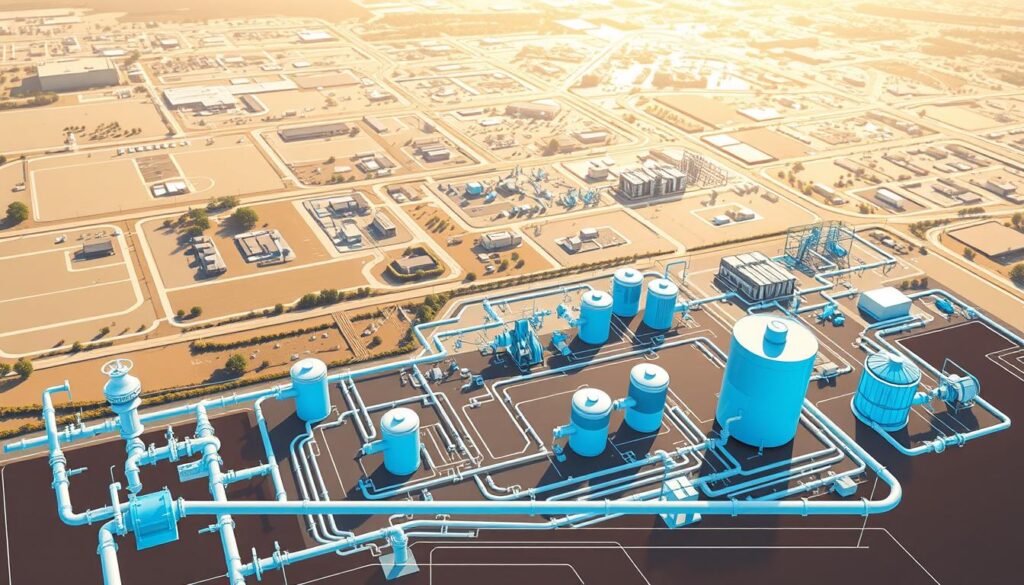
Pressure Management in Distribution
Effective pressure management is critical to prevent pipe bursts and minimize leakage. Techniques include the use of pressure-reducing valves and the implementation of district metered areas (DMAs).
Proper pipe sizing is also essential to minimize pressure drops and ensure an even distribution of water across the system.
System Layout Considerations
The layout of the distribution system should be designed to reduce unnecessary bends and friction losses, thereby optimizing the flow of water. Strategic routing and the use of loops can enhance the reliability of the water supply.
By considering these factors, hydraulic engineers can design a distribution system that is both efficient and reliable.
Hydraulic Modeling in Design
The use of hydraulic modeling in water infrastructure design has become indispensable for predicting system behavior under various conditions. Hydraulic modeling allows engineers to simulate the behavior of water supply systems, enabling them to optimize system performance and identify potential issues before they become major problems.
Purpose and Benefits
The primary purpose of hydraulic modeling is to simulate the behavior of water supply systems under different scenarios, such as varying demand conditions or pipe failures. By doing so, engineers can optimize system design and operation to ensure reliability and efficiency. Hydraulic modeling helps in identifying potential issues such as low pressures, high velocities, and water quality problems, allowing for proactive measures to mitigate these risks.
Moreover, hydraulic modeling enables the evaluation of different design alternatives and operational strategies, facilitating informed decision-making. It can also be used to assess the impact of future changes in demand or supply on the system’s performance.
Software Tools and Applications
Various software tools are available for hydraulic modeling, including EPANET, WaterCAD, and InfoWorks WS. These tools provide advanced capabilities for simulating complex water distribution systems, including extended period simulations and water quality modeling. By utilizing these software tools, engineers can create detailed models that accurately represent the behavior of real-world systems.
The application of these tools is not limited to design; they are also used for operational optimization and troubleshooting existing systems. For instance, hydraulic models can be used to identify areas of high energy loss or to optimize pump scheduling.
Interpreting Modeling Results
Interpreting the results of hydraulic modeling is critical for identifying potential issues and optimizing system performance. Engineers must analyze the simulation results to understand how the system behaves under different conditions. This involves examining parameters such as pressure, flow rate, and water age to ensure they are within acceptable limits.
Effective interpretation of modeling results requires a deep understanding of both the hydraulic model and the physical system it represents. It also involves considering the limitations and uncertainties associated with the model and its inputs.
Energy Efficiency in Water Supply Systems
Energy efficiency plays a vital role in the design and operation of water supply systems. As the demand for water continues to grow, optimizing energy use in these systems becomes increasingly important for reducing operational costs and environmental impact.

Renewable Energy Options
One of the key strategies for enhancing energy efficiency in water supply systems is the integration of renewable energy sources. Solar and wind power can be used to drive pumps and other equipment, reducing reliance on fossil fuels. According to the EPA guidelines, incorporating renewable energy can significantly lower the carbon footprint of water supply operations.
- Solar-powered pumping systems
- Wind energy for water treatment
- Hybrid systems combining different renewable sources
Pumping Efficiency Strategies
Pumping is a major energy-intensive activity in water supply systems. Improving pumping efficiency can be achieved through:
- Using variable-speed pumps to match supply with demand
- Optimizing pump design for specific applications
- Regular maintenance to prevent efficiency losses
By implementing these strategies, water utilities can significantly reduce their energy consumption and operational costs.
Reducing Operational Costs
In addition to improving energy efficiency, reducing operational costs is crucial for sustainable water supply systems. This can be achieved by:
- Implementing smart water metering and monitoring systems
- Adopting rainwater harvesting and other water-saving technologies
- Optimizing system design to minimize energy use
By combining these approaches, water supply systems can become more efficient, cost-effective, and environmentally friendly.
Smart Water Supply Technologies
Advancements in smart technologies are enhancing the efficiency and reliability of water supply systems. The integration of these technologies is crucial for achieving a sustainable water supply.
IoT in Water Management
The Internet of Things (IoT) plays a significant role in modern water management. By leveraging IoT devices, water utilities can monitor and manage their systems more effectively. For instance, IoT sensors can be used to track water quality, detect leaks, and optimize water treatment plant design.
Benefits of Smart Metering
Smart metering is another critical component of smart water supply technologies. It allows for real-time monitoring of water usage, enabling utilities to identify areas of inefficiency and implement corrective measures. The benefits of smart metering include:
- Improved accuracy in billing
- Enhanced customer engagement through detailed usage data
- Early detection of leaks and anomalies
| Benefits | Description | Impact |
|---|---|---|
| Improved Accuracy | Real-time data collection | Reduced billing errors |
| Customer Engagement | Detailed usage insights | Increased customer satisfaction |
| Leak Detection | Anomaly detection systems | Water conservation |
Automation and Control Systems
Automation and control systems are vital for optimizing water distribution and treatment processes. These systems enable utilities to respond quickly to changes in demand and supply, ensuring a reliable water supply. By automating routine tasks, utilities can also reduce operational costs and improve overall efficiency.
In conclusion, smart water supply technologies, including IoT, smart metering, and automation and control systems, are transforming the water utility landscape. By embracing these technologies, utilities can achieve a more sustainable water supply and improve their overall service delivery.
Water Supply System Maintenance
The integrity of a water supply system depends heavily on regular and thorough maintenance practices. Maintaining the system’s infrastructure is crucial for ensuring the delivery of clean and safe water to consumers.
Importance of Regular Maintenance
Regular maintenance is essential for keeping the distribution system in optimal condition. This includes inspecting pipes, valves, and pumps for signs of wear and tear, cleaning and flushing the network, and performing routine checks on pressure and flow rates. According to a report on operation and maintenance of water supply systems, “regular maintenance is key to preventing system failures and ensuring the longevity of the infrastructure” Module 2: Operation & Maintenance of Water Supply.
| Maintenance Activity | Frequency | Purpose |
|---|---|---|
| Inspecting Pipes and Valves | Quarterly | Identify signs of wear and tear |
| Cleaning and Flushing | Bi-annually | Remove sediment and debris |
| Pressure and Flow Rate Checks | Monthly | Ensure system operates within designed parameters |
Common Maintenance Practices
Effective maintenance practices involve a combination of routine inspections, cleaning, and repairs. For instance, predictive maintenance techniques can be used to forecast potential failures, allowing for proactive measures to be taken. Additionally, maintaining accurate records of maintenance activities is crucial for planning future upgrades and ensuring compliance with regulatory standards.
“A well-maintained water supply system not only ensures the health and safety of the community but also contributes to the overall efficiency and sustainability of the water supply infrastructure.”
Planning for System Upgrades
Planning for system upgrades is an integral part of water supply system maintenance. This involves assessing the current state of the infrastructure, identifying areas that require improvement, and implementing upgrades to enhance performance and efficiency. Hydraulic engineering plays a critical role in this process, as it involves designing and optimizing the system to meet current and future demands.
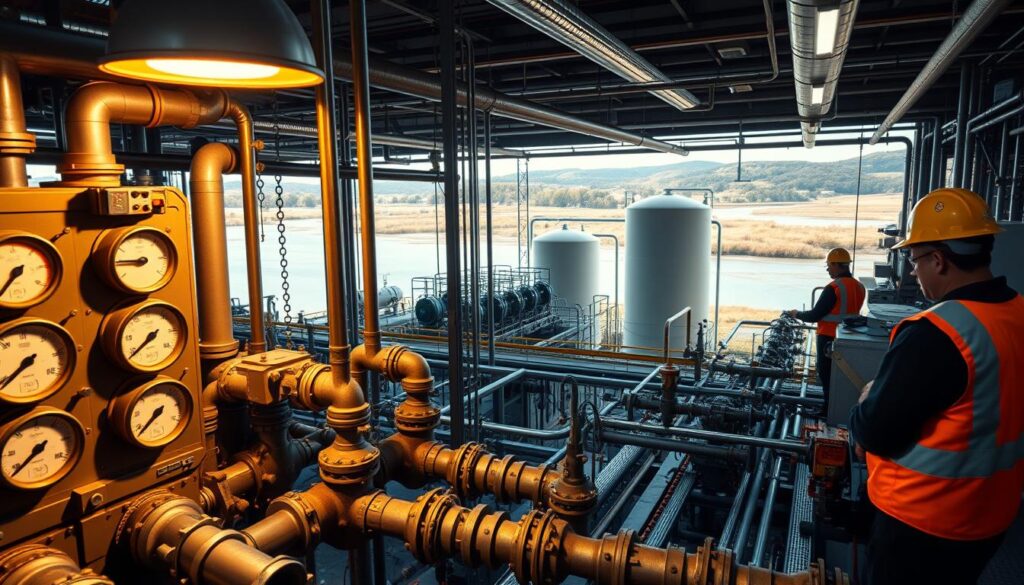
By prioritizing maintenance and planning for upgrades, water supply systems can be optimized to provide safe, reliable, and efficient service to communities. This not only supports public health but also contributes to environmental sustainability and economic viability.
Regulatory and Compliance Issues
Compliance with regulatory standards is a cornerstone of water infrastructure design. Ensuring that water supply systems meet or exceed these standards is crucial for public health, safety, and environmental protection.
“The safety and reliability of water supply systems depend heavily on adherence to regulatory requirements,” as emphasized by water management experts. This adherence not only guarantees the quality of the water supply but also helps in avoiding costly modifications or regulatory issues down the line.
Key Regulations in the U.S.
In the United States, the water supply industry is governed by a complex set of regulations. The Safe Drinking Water Act (SDWA) is a pivotal piece of legislation that authorizes the Environmental Protection Agency (EPA) to set standards for drinking water quality.
- The SDWA ensures that water supply systems provide safe drinking water.
- Other regulations, such as the Clean Water Act, play a crucial role in protecting water sources.
Permitting and Inspection Processes
The process of obtaining permits and undergoing inspections is a critical aspect of ensuring compliance in water distribution system design and operation. These processes verify that the system meets all relevant standards and regulations.
Regular inspections help identify potential issues before they become major problems, ensuring the continued safety and efficiency of the water supply.
Ensuring Safe Water Supply
Ensuring a safe water supply involves not just compliance with regulations but also proactive measures to protect water sources and treatment processes. This includes implementing robust security measures and maintaining infrastructure.
“Investing in water infrastructure is not just about compliance; it’s about ensuring a safe and reliable water supply for future generations.”
By prioritizing regulatory compliance and proactive management, water supply systems can provide safe, reliable water while minimizing environmental impact.
Community Involvement in Design
Effective water supply system design requires more than just technical expertise; it demands active community involvement. Engaging with the community ensures that the system meets the actual needs of its users, fostering a sense of ownership and responsibility among stakeholders.
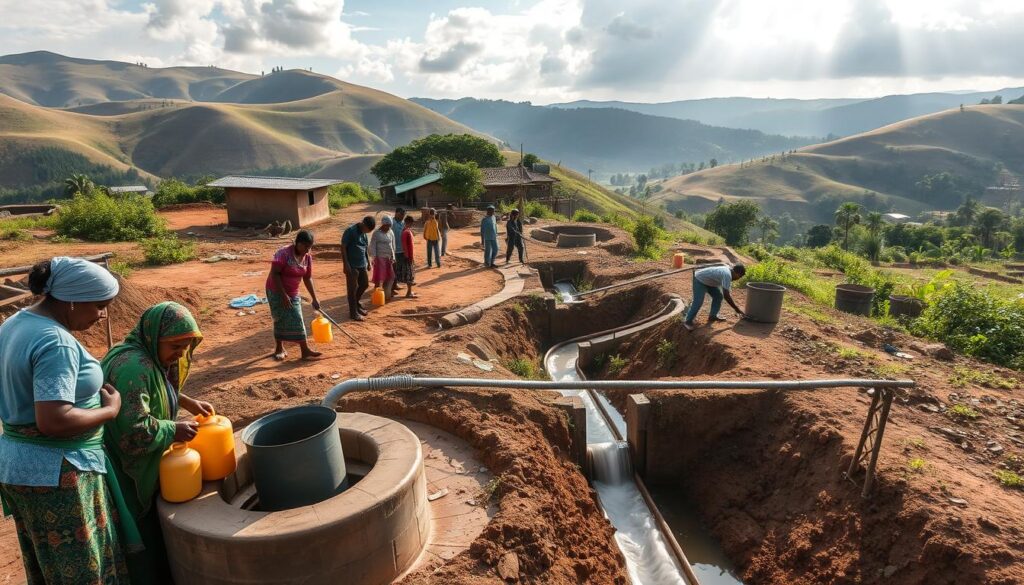
Engaging Stakeholders
Engaging stakeholders is a critical step in the design process. It involves identifying key community members, understanding their concerns, and incorporating their feedback into the system design. This can be achieved through public meetings, surveys, and other participatory mechanisms.
Stakeholder engagement not only helps in understanding the community’s needs but also in building trust and support for the project. It’s essential to maintain transparent communication channels to keep stakeholders informed about the project’s progress and any changes.
Public Education on Water Use
Educating the public on water use is another vital aspect of community involvement. By raising awareness about the importance of water conservation and the impact of individual actions on the overall water supply system, communities can promote more efficient water use practices.
- Workshops and seminars can be organized to educate the public about water-saving techniques.
- Informational campaigns can be launched to highlight the benefits of water conservation.
- Community events can serve as platforms to engage the public in discussions about water use and management.
Feedback Mechanisms
Establishing feedback mechanisms is crucial for understanding community needs and concerns. This can be done through regular surveys, complaint systems, or digital platforms where community members can provide their input on the water supply system.
Continuous feedback allows for the identification of areas for improvement and ensures that the water supply system remains responsive to the community’s evolving needs. It’s a key component of adaptive management and long-term sustainability.
By integrating community involvement into the design process, water supply systems can be made more effective, sustainable, and responsive to the needs of their users. This approach not only enhances the system’s performance but also contributes to the overall well-being of the community.
Case Studies in Water Supply Design
Examining case studies in water supply design reveals valuable insights into best practices and common pitfalls. By analyzing successful projects, we can identify key factors that contribute to their effectiveness.
Successful Projects in Urban Areas
Urban water supply projects often face unique challenges, such as high population density and infrastructure constraints. A notable example is the water supply system designed for a major metropolitan area, which incorporated advanced technologies like IoT sensors and smart metering to optimize water distribution. According to a report by World Civil Society, such innovations have significantly improved the efficiency of urban water supply systems.
The use of hydraulic modeling software was instrumental in designing the distribution network, allowing engineers to simulate various scenarios and optimize pipe sizing. As noted in a study published on ASEE, this approach enabled the design team to minimize energy consumption while ensuring reliable water supply to the population.
| Project | Key Features | Outcomes |
|---|---|---|
| Urban Water Supply Project | IoT sensors, smart metering, hydraulic modeling | Improved efficiency, reduced energy consumption |
| Rural Water Supply Initiative | Community engagement, rainwater harvesting, simple treatment processes | Sustainable water supply, community empowerment |
Rural Water Supply Innovations
Rural areas often require tailored solutions due to limited infrastructure and resources. A successful rural water supply project utilized community engagement and participation to design a sustainable water supply system. The project incorporated rainwater harvesting and simple, low-cost treatment processes, ensuring a reliable and safe water supply for the community.
“Community involvement is crucial for the success of rural water supply projects. By engaging local stakeholders, we can design systems that meet their needs and are sustainable in the long term.”
Lessons Learned from Failures
Not all water supply projects are successful, and analyzing failures can provide valuable lessons. Common issues include inadequate planning, poor design, and lack of maintenance. A case study on a failed water supply project highlighted the importance of thorough hydraulic modeling and consideration of future demand.
By understanding the causes of failure, we can improve future water supply system design. As A-Square MEP Consultants notes, “Examining Efficient Water Supply Systems, including key factors, components, and best practices, is essential for designing successful projects.”
In conclusion, case studies in water supply design offer valuable insights into successful strategies and common pitfalls. By applying these lessons, we can design more effective and sustainable water supply systems.
Future Trends in Water Supply Design
The future of water supply design will be shaped by several key factors, including the impacts of climate change, emerging technologies, and the adoption of sustainable practices. Understanding these trends is crucial for designing resilient water supply systems that can meet the needs of communities now and in the future.
Impacts of Climate Change
Climate change is altering precipitation patterns, increasing the frequency of extreme weather events, and affecting water availability. Water supply design must adapt to these changes by incorporating climate resilience into system planning and operation. This includes:
- Designing systems that can handle more frequent and intense floods and droughts.
- Incorporating climate projections into water resource planning.
- Enhancing the flexibility and adaptability of water supply infrastructure.
Climate-resilient design is not just about withstanding the impacts of climate change; it’s also about ensuring that water supply systems can continue to provide safe and reliable water under a range of future climate scenarios.
Emerging Technologies
Emerging technologies are transforming the water supply landscape. Some of the key technologies include:
- Advanced water treatment technologies that can remove a wider range of contaminants, improving water quality.
- Smart water grids that use real-time data and analytics to optimize water distribution and detect leaks.
- Renewable energy integration into water supply systems, reducing their carbon footprint.
These technologies not only improve the efficiency and reliability of water supply systems but also contribute to sustainability by reducing energy consumption and environmental impact.
Sustainable Practices
Sustainability is becoming increasingly important in water supply design. This involves adopting practices that minimize environmental impact, conserve resources, and ensure long-term viability. Key sustainable practices include:
- Implementing water-saving measures and promoting water efficiency.
- Using recycled water for non-potable purposes.
- Protecting and restoring natural water habitats.
As noted by water management experts, “Sustainable water supply design is not just about meeting current needs but also about ensuring that future generations have access to clean and reliable water.”
“The goal is to create water supply systems that are not only efficient and reliable but also environmentally sustainable and socially equitable.”
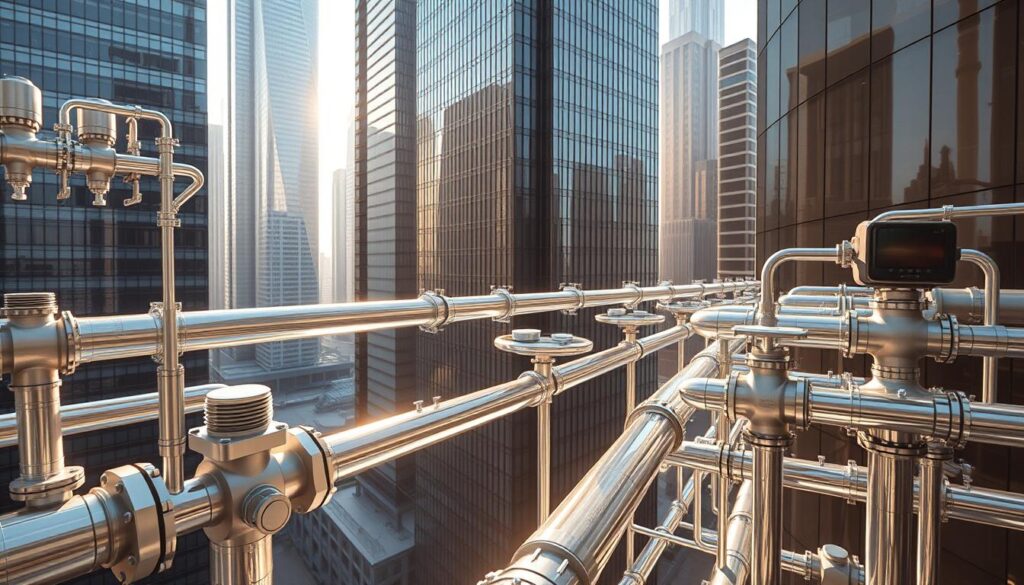
In conclusion, the future of water supply design will be characterized by a focus on climate resilience, technological innovation, and sustainability. By embracing these trends, we can create water supply systems that are better equipped to meet the challenges of the future.
Conclusion: The Path Forward
Efficient water supply systems are the backbone of modern infrastructure, supporting public health, economic development, and environmental sustainability. As highlighted in previous sections, effective water reuse practices and hydraulic engineering play crucial roles in achieving these goals.
Key Takeaways
States like Arizona, California, Florida, and Colorado are pioneering water reuse initiatives, showcasing the potential for innovative water infrastructure design to address future challenges. By understanding water demand, selecting appropriate sources, and implementing efficient treatment and distribution systems, communities can ensure a reliable water supply.
Future Vision
As we move forward, integrating smart technologies and sustainable practices into water supply design will be essential. By leveraging advancements in hydraulic engineering and water infrastructure design, we can create resilient systems that meet the needs of a growing population while protecting the environment.
Responsible Water Use
Encouraging responsible water use through public education and community engagement is vital for the long-term success of water supply systems. By working together, we can ensure a sustainable water future for generations to come.
